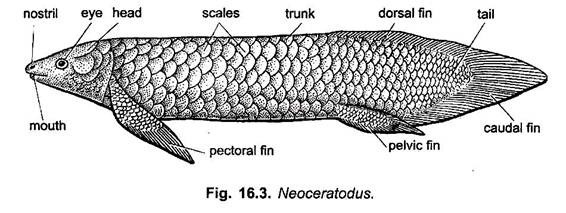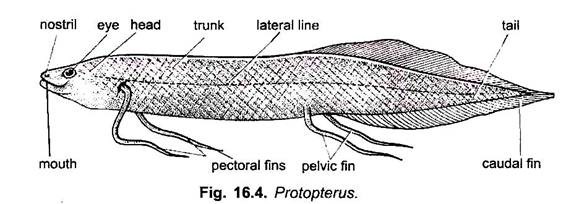The Dipnoi, commonly known as lung-fish, are considered to be specialised or degenerate descendants of the primitive lobe fins which they closely resemble. Dipnoi are Devonian offshoot from the crossopterygian stem. They still survive as three degenerate and specialised forms in widely separated tropical or subtropical, freshwater habitats of a special kind. Lung-fishes appear first in mid-Devonian, flourished moderately in the Permian and Triassic, and then became rare.
The living Dipnoi are Neoceratodus of South-Eastern Queensland, Protopterus of Africa, and Lepidosiren of South America. They possess internal nostrils. They breathe by means of gills and a highly developed lung. Neoceratodus is able to live in stagnant water and never dies if removed from water. Protopterus and Lepidosiren can survive the drying of the environment by aestivating in mud with small aperture to allow respiration. Protopterus secretes slimy protective cocoon. In both Protopterus and Lepidosiren an epiglottis occurs.
Lung fishes have bony scales and dermal fin-rays. Paired fins are unlike those of other fishes and are constructed on the biserial plan-archipterygium, i.e., an elongated axis extending out from the body and bearing pre- and post-axial rays. The post-axial rays are fewer in number than the preaxial.
The notochord is persistent. There are no vertebral centra. There are four to six cartilaginous branchial arches. Dermal fin-rays are more or less ossified and are supported by numerous cartilaginous or ossified pterygiophores.
ADVERTISEMENTS:
The caudal fin is often diphycercal. The pectoral arch is a single cartilage with a pair of superficial investing bones on each side. The pelvic arch is well developed and cartilaginous. Gills are covered by operculum. Dermal skeleton is formed by over-lapping cycloid scales. In the heart, atrium and sinus venosus are imperfectly divided into two parts.
The contractile conus arteriosus is partly or completely divided by a longitudinal partition. A pulmonary artery arises from the efferent branchial system on each side, and a pulmonary vein opens into the left division of the atrium.
The larva of Lepidosiren and Protopterus possesses both suckers and external gills. Adults of some species of Protopterus possess remains of these gills. Paired oviducts open anteriorly into coelom. Male vasa efferentia carry sperms through the excretory part of the mesonephros.
Neoceratodus:
Neoceratodus (Fig. 16.3) is commonly known as Australian lung fish or Burnett salmon. Body is elongated and compressed measuring about 1.5 metres or more. Scales are large, thin and covered with spines which are not regarded as denticles. Paired fins are rather leaf-like or paddle-like. Caudal fin is symmetrical and pointed. Dental plates are oval crescentic or triangular terminating in smooth or feebly denticulated biting margins.
Lower jaw with a small toothless dentary on each side. Branchial arches are five in number and bisegmented. Hyobranchial-cleft is open and associated with pseudobranch. The first four branchial-arches carry holobranchs. Air-bladder is single. It cannot survive out of water.
The lateral line system is somewhat degenerated. Inactive and sluggish in habit, usually lying motionless on the bottom. Carnivorous. Feeds on freshwater crustaceans, worms and molluscs. Neoceratodus is found in Burnett and Mary rivers in Queensland, Australia.
Protopterus:
Protopterus (Fig. 16.4) is commonly known as Nile lung fish or African Lung fish. Body is elongated, cylindrical and more or less eel-like and grows to a length of 2 metres. Small cycloid scales are completely enclosed in the skin. The paired fins are long, thin and filamentous. Dorsal and caudal fins are united. Tail is principal organ of locomotion. Six branchial arches and five pairs of gill-slits are covered by operculum. Larval gills are usually retained as vestiges throughout life.
Air-bladder is double lung. It is said to breathe by its lungs as well as by its gills. Carnivorous and voracious feeder. During unfavourable seasons it undergoes summer sleep and burrow into the soil to a depth of about 60.0 cm. Protopterus has a wide distribution over the middle portion of great African continent ranging from the river Senegal and the White Nile on the north to the Congo basin. Lake Tanganiyika and Zambesi on the south.
Lepidosiren:
ADVERTISEMENTS:
Lepidosiren (Fig. 16.5) is commonly known as South American lung fish. Body is elongated, cylindrical and more or less eel-like. The skin covering the body contains the small cycloid scales. Paired fins are thin and filamentous. Dorsal and caudal fins are united.
Tail is principal organs of locomotion. Five branchial arches and four pairs of gill-slits are covered by operculum. Cutaneous gills disappear soon after the larval metamorphosis. Air-bladder is double lung. It is not exclusively carnivorous. Food chiefly comprises fresh snails and mass of algae. Lepidosiren occurs along the course of main Amazon river.


